| This article needs additional citations for verification. Please help improve this article by adding citations to reliable sources. Unsourced material may be challenged and removed. (May 2008) |
- See also: Renault FT-17 (EST)
| Renault FT | |
|---|---|
 FT at Brussels Royal Army Museum | |
| Type | Light tank |
| Place of origin | |
| Service history | |
| In service | 1917–1945 |
| Used by | See Users |
| Wars | World War I, Russian Civil War, Polish-Soviet War, Chinese Civil War, Spanish Civil War, World War II, French-Thai War, Turkish War of Independence (by France); 1948 Arab–Israeli War (by Egypt); Winter War (by Finland)[1] |
| Production history | |
| Designer | Rodolphe Ernst-Metzmaier |
| Designed | 1917 |
| Manufacturer | Renault |
| Number built | ~3,694 (see text) |
| Variants | Char à canon 37, Char mitrailleur, FT 75 BS , Char signal, FT modifié 31, Six Ton Tank Model 1917, Russkiy Reno, FIAT 3000 |
| Specifications | |
| Weight | 6.5 tonnes (6.4 long tons/7.2 short tons) |
| Length | 5.00 m (16 ft 5 in) |
| Width | 1.74 m (5.7 ft) |
| Height | 2.14 m (7.0 ft) |
| Crew | 2 (commander, driver) |
| Armor | 22 mm (0.87 in) |
| Primary armament |
37 mm gun or 7.92 mm machine gun |
| Engine | Renault 4-cyl petrol 39 hp (29 kW) |
| Power/weight | 6 hp/tonne |
| Transmission | sliding |
| Suspension | vertical springs |
| Operational range |
65 km (40 mi) |
| Speed | 7 km/h (4.3 mph) |
The Renault FT, frequently referred to in post-WWI literature as the "FT-17" or "FT17" (see Nomenclature), was a French light tank; it is among the most revolutionary and influential tank designs in history. The FT was the first operational tank with an armament in a fully rotating turret,[nb 1] and its configuration with the turret on top, engine in the back and the driver in front became the conventional one, repeated in most tanks until today. Armour historian Steven Zaloga has called the Renault FT "the world's first modern tank".[2]
Development[]
Studies on the production of a new light tank were started in May 1916 by the famous car producer Louis Renault. The evidence strongly suggests that Renault himself drew up the preliminary design, being unconvinced that a sufficient power/weight ratio could be achieved for the medium tanks requested by the military. One of his most talented designers, Rodolphe Ernst-Metzmaier, prepared the final drawings.
Though the project was far more advanced than the two first French tanks about to enter production, the Schneider CA1 and the heavy Saint-Chamond, Renault had at first great trouble getting it accepted. Even after the first British use of tanks, on 15 September 1916, when the French people called for the deployment of their own chars, the production of the light tank was almost cancelled in favour of that of a superheavy tank (the later Char 2C). However, with the unwavering support of Colonel (later General) Jean Baptiste Eugène Estienne (1860–1936), the "Father of the Tanks", and the successive French Commanders in Chief, who saw light tanks as a more feasible and realistic option, Renault was at last able to proceed with the design. However, competition with the Char 2C was to last until the very end of the war.
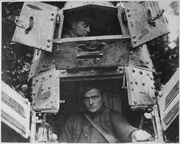
Crew locations shown with panels open
The prototype was slowly refined during the first half of 1917. Early production FTs were often plagued by radiator fan belt and cooling system problems, a characteristic that persisted throughout World War I. Only 84 were produced in 1917 but 2,697 were delivered before the end of the war. At least 3,177 were produced in total, perhaps more; some estimates go as high as 4,000 for all versions combined. However, 3,177 is the delivery total to the French Army; 514 were perhaps directly delivered to the U.S. Army, 24 to Great Britain, and three to Italy - giving a probable total production number of 3,694. The tanks had at first a round cast turret; later either an octagonal turret or an even later rounded turret of bent steel plate (called the Girod turret, after one of the factories that produced it). The latter two could carry a Puteaux SA 18 gun, or a 7.92 mm Hotchkiss machine gun. In the U.S., a slightly modified version was built under licence as the Six Ton Tank or M1917 (950 built, 64 before the end of the war, but too late to be used in action).
Service history[]
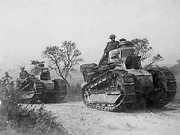
US Army operating Renault FT tanks
The FT was widely used by the French and the US in the later stages of World War I, after 31 May 1918. It was cheap and well-suited for mass production. It reflected an emphasis on quantity, both on a tactical level: Estienne proposed to overwhelm the enemy defences by a "swarm" of light tanks, and on a geostrategic level: the Entente was thought to be able to gain the upper hand by outproducing the Central Powers. A goal was set of 12,260 to be manufactured (including 4,440 of the USA version) before the end of 1919.
After the war, FTs were exported to many countries (Poland, Finland, Estonia, Lithuania, Romania, Yugoslavia, Czechoslovakia, Switzerland, Belgium, Netherlands, Spain, Brazil, Turkey, Iran, Afghanistan and Japan). As a result, FT tanks were used by most nations having armoured forces, invariably as their first tank type, including the United States. They took part in many later conflicts, such as the Russian Civil War, Polish-Soviet War, Chinese Civil War, Rif War , Spanish Civil War and Estonian War of Independence.
FT tanks were also used in the Second World War, among others in Poland, Finland, France and Kingdom of Yugoslavia, although they were completely obsolete by then. In 1940 the French army still had eight battalions equipped with 63 FTs each and three independent companies with ten each, for a total organic strength of 534, all with machine guns.
Many smaller units, partially raised after the invasion, also used the tank. This has given rise to the popular myth that the French had no modern equipment at all; in fact they had more modern tanks than the Germans[3]; the French suffered from tactical and strategic weaknesses rather than from equipment deficiencies. When the German drive to the Channel cut off the best French units, as an expediency measure the complete French materiel reserve was sent to the front; this included 575 FTs. Earlier 115 sections of FT had been formed for airbase-defence. The Wehrmacht captured 1,704 FTs. A hundred were again used for airfield defence, about 650 for patrolling occupied Europe. Some of the tanks were also used by the Germans in 1944 for street-fighting in Paris. By this time they were hopelessly out of date.
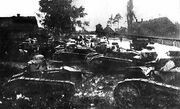
Polish FT tanks during the Battle of Dyneburg
The FT was the ancestor of a long line of French tanks: the FT Kégresse, the NC1, the NC2, the Char D1 and the Char D2. The Italians produced as their standard tank the FIAT 3000, a moderately close copy of the FT.
The Soviet Red Army captured fourteen burnt-out Renaults from White Russian forces, and rebuilt them at the Krasnoye Sormovo Factory in 1920. The Soviets claimed to have originally manufactured these Russkiy Reno tanks, but they actually produced only one exact copy, named 'Freedom Fighter Comrade Lenin'.[4] When Stalin began the arms race of the Thirties, the first completely Soviet-designed tank was the T-18, a derivation of the Renault with sprung suspension.
In all, the FT was used by Afghanistan, Belgium, Brazil, the Republic of China, Czechoslovakia, Estonia, Finland, France, Nazi Germany, Iran, Japan, Lithuania, the Netherlands, Poland, Romania, the Russian White movement, the Soviet Union, Spain, Sweden, Switzerland, Turkey, Norway, the United Kingdom, the United States and the Kingdom of Yugoslavia.
Nomenclature[]
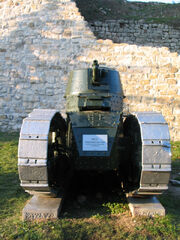
FT at Belgrade Military Museum, Serbia.
Much confusion surrounds the name of this tank.
It is sometimes stated that the letters FT stand for the French terms faible tonnage (low tonnage) or franchisseur de tranchées (trench crosser). Neither is correct. Nor was it named the FT 17 or FT-17.
All new Renault projects were given a two-letter product code for internal use, and the next one available was 'FT.'
The prototype was at first referred to as the automitrailleuse à chenilles Renault FT modèle 1917. Automitrailleuse à chenilles means "armoured car with tracks." Automitrailleuse was the standard word for an armoured car, but by the time the FT went into mass production there were two other types of French tank in existence and the term char d'assaut (from the French char - a cart or wagon, and assaut; attack or assault), soon shortened to char, had on the insistence on Colonel Estienne already been adopted by the French and was in common use. Once orders for the vehicle had been secured it was the practice at Renault to refer to it as the "FT." The vehicle was originally intended to carry a machine-gun, and was therefore described as a char mitrailleur. Mitrailleur (from mitraille; grapeshot) had by this time come to mean "machine-gunner."[5][6]
Many sources, predominantly English language accounts, refer to the FT as the "FT 17" or "FT-17." This term is not contemporary, and appears to have arisen post World War One. In Estienne's biography,[7] his granddaughter states, "It is also referred to as the FT 17: the number 17 was added after the war in history books, since it was always referred to at Renault as the FT." Lieutenant-Colonel Paul Malmassari (French tank officer and Doctor of History) states, "The Renault tank never carried the name FT 17 during the First World War, although the initials F.T. seem to appear in August 1917."[8] Some confusion might also have been caused by the fact that the American version of the vehicle, produced in the USA under licence from Renault, was designated the M1917.
When it was decided to equip the FTs with either cannon or machine-guns, the cannon version was designated char canon (cannon tank) and the latter, in accordance with French grammar, renamed char mitrailleuse (machine-gun tank).
It is frequently claimed that some of these tanks were designated FT 18. Reasons given for the claim include: it distinguished tanks produced in 1918 from those of 1917; it was applied to FTs armed with cannon as opposed to those those with machine-guns; it distinguished FTs with a cast, rounded turret from those with a hexagonal one; it referred to the 18 horsepower engine; it indicated a version to which various modifications had been made.
However, Renault records make no distinction between 1917 and 1918 output; the decision to arm FTs with a 37mm gun was made in April, 1917, before any tanks had been manufactured; because of various production difficulties and design requirements, a range of types of turret were produced by several manufacturers, but they were all fitted to the basic FT body without any distinguishing reference; all FTs had the same model 18hp engine. The Renault manual of April, 1918 is entitled RENAULT CHAR D'ASSAUT 18 HP, and the illustrations are of the machine-gun version. The official designation was not changed until the 1930s, when the FT was fitted with a Model 1931 machine-gun and renamed the FT31. By this time the French Army was equipped with several other Renault models and it had become necessary to distinguish between the various types. World War One variants were named Renault 75BS (carrying a short 75mm cannon) and Renault TSF (radio tank).[9][10][11][12][13]
Variants[]
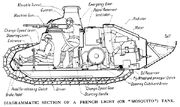
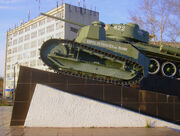
Monument to first Soviet tank in Nizhny Novgorod. It is installed copy (not original) of "Russky Reno"
- Char canon: an FT with a 37 mm Puteaux SA18 short-barreled gun - about 3/5 of tanks ordered, about 1/3 of tanks actually produced.
- Char mitrailleuse: an FT with an 8 mm Hotchkiss M1914 machine gun - about 2/5 of tanks ordered, about 3/5 of tanks produced.
- FT 75 BS: a self propelled gun with a 75 mm Blockhaus Schneider petard (short-barreled howitzer) - at least 39 tanks were produced.
- Char signal or TSF: a command tank with a radio, "TSF" stands for télégraphie sans fil or "wireless" - a very apt name, as morse code was to be used only; no armament, three-men crew, 300 ordered, at least 188 produced.
- FT modifié 31: upgraded tanks with 7.5 mm Reibel machine gun. This modification started in 1931 on the 1580 chars mitrailleurs still in French stocks; all the metropolitan guntanks were (at least officially) scrapped to build utility vehicles on their chassis and the guns used to equip the R 35. This version was sometimes referred to as the "FT 31", though this was not the official name.
- FT-Ko: Thirteen modified units imported by the Imperial Japanese Army in 1919, armed with either the 37 mm Puteaux SA18 cannon or machine guns; used in combat in the Manchurian Incident and subsequently for training[14]
- Six Ton Tank Model 1917 - US-built copy, 950 built, 374 of which were gun tanks, and fifty of which were radio tanks. During World War II some were delivered to Canada and the UK for use as training vehicles.
- Russkiy Reno: the "Russian Renault", the first Soviet tank, produced at Krasnoye Sormovo, a close copy.
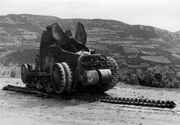
A Yugoslavian M26/27 tank destroyed in the 1941 Invasion of Yugoslavia.
- Renault FT CWS: the Renault FT CWS or "Zelazny" (mild steel) tanks were built in Poland, for use as training vehicles only (Polish combat tanks were French manufactured). These tanks used spare French engines and components.The hulls and turrets were manufactured to French specs in all other respects. 27 CWS FT17 tanks were built around. CWS is the abbreviation for Centralnych Warsztatach Samochodowych, meaning "Central Workshops for Motor vehicles or "Central Truck Workshop", which was a plant located in Warsaw, which performed maintenance and depot level repair.[15][16]
- Renault M26/27: a development of the FT with a different suspension and Kégresse rubber tracks; a number were used in Yugoslavia and five in Poland.[17]
- T-18 – A Soviet derivation with sprung suspension.
- FIAT 3000 - an Italian derivation.
- Polish gas tank - A Polish modification built in the Wojskowy Instytut Gazowy (Military Gas Institute) and tested on the Rembertów proving ground on 5 July 1926. Instead of a turret, the tank had twin gas cylinders. It was designed to create smoke screens, but could also be used for chemical attacks. There was only one exemplar of this tank.
Surviving Vehicles[]
Approximately 41 FTs ,[18] twenty Six-Ton Tanks,[19] two Russkiy Renos and three FT TSF survive in various museums around the world.
- Musée des Blindés, Saumur, France. The museum owns three FTs, two of them are in running condition. One of them is coming from the Patton Museum.[20] The third is in static display and comes from Afghanistan. It is one of 4 known FTs that were in this country before 2003, two of them went to the Patton Museum in Fort Knox, the 4th one is still preserved in Kaboul. The Saumur tank museum also owns a FT TSF, it currently has no tracks and driving train, but the museum intends to restore it.
- Musee de l'Armee, Paris, France. One FT.
- Old Rhinebeck Aerodrome in Rhinebeck, NY. One driveable Six-Ton Tank.
- Hayes Otoupalik, Military Collectibles and Historical Americana, Missoula, Montana. One driveable Six-Ton Tank. Tank is from the personal collection of Hayes Otoupalik. He owned a French Renault FT, sold to the National World War I Museum. [21]
- Bovington Tank Museum, United Kingdom. One FT, an unarmoured training model.[22]
- Museu Militar Conde de Linhares in Rio de Janeiro, Brazil. One FT.
- Ropkey Armor Museum, Crawfordsville, Indiana A Six-Ton Model 1917.[23][24]
- Patton Museum in the United States. In 2003, two FT tanks were discovered in Kabul, Afghanistan by Major Robert Redding. With permission from the Afghan government, the two tanks were transferred here, where one of them was restored and is now on display.[25] The museum previously owned a FT tank, but at the request of the French government, sent it back to France. [20]
- Louisiana State Military Museum at Jackson Barracks, New Orleans, Louisiana. An FT was inundated by floodwaters of Hurricane Katrina in 2005. It is being restored and will be returned to display.
- Royal Military Museum, Belgium. One FT is on permanent display.[26]
- The National World War I Museum, located at Liberty Memorial , Kansas City, Missouri. An FT, damaged by German artillery.[27]
- Musée de l'armée Suisse, Burgdorf, Switzerland. An FT is displayed as the first tank of the Swiss army, adopted in 1922. [28]
- National Military Museum (Romania), Bucharest, Romania. An FT, in permanent outdoor display.[29]
- Military Museum (Belgrade), Belgrade, Serbia. An FT, in permanent outdoor display.[30]
- Parola Tank Museum, Parola, Finland. FT in outdoor display. [31]
- Two full-scale, working replicas of Renault FTs were built from scratch by enthusiast for Jerzy Hoffman's Battle of Warsaw 1920 2011 film.
- An FT is being placed on static display at the U.S. Army Heritage and Education Center in Carlisle, PA beginning in April 2012.
- The US First Infantry Division museum at Cantigny in Warrenville, IL has an M1917 on static display in the tank park outside.
- The Afghan National Army has begun a restoration project on an FT, intending to place it in a static display outside the new Ministry of Defence Headquarters in Kabul, once construction of the building is complete.
See also[]
Notes[]
- Notes
- ↑ The British prototype tank "Number 1 Lincoln Machine" was fitted with a turret but the design was not carried over into the first British tanks to enter service
- Citations
- ↑ "Fire and Ice, The Winter War of Finland and Russia". Wfyi.org. Retrieved on 2011-02-04.
- ↑ Steven J. Zaloga, The Renault FT Light Tank, London 1988, p. 3
- ↑ J P Harris & F N Toase, Armoured Warfare, Basford 1990, p. 62
- ↑ Zaloga & Grandsen 1984:35
- ↑ Danjou, Pascal: Renault FT, Editions du Barboutin, 2009. P6, p10.
- ↑ Malmassari, Lt-Col. P. Les Chars de la Grande Guerre, Groupe Hommell, 2009. P62 (quoting Col. J.B.E. Estienne), p65
- ↑ Mondet, Arlette Estienne: Le général J.B.E. Estienne, père des chars. L'Harmattan, 2010
- ↑ Malmassari, P: Les chars de la Grande Guerre. Groupe Hommell, 2009.
- ↑ Jeudy, Jean-Gabriel; Chars de France. E.T.A.I., 1997.
- ↑ Zaloga, Steven J.; The Renault FT Light Tank. London, 1988.
- ↑ Danjou, Pascal; Renault FT. Editions du Barbotin, 2009.
- ↑ Ramspacher, Colonel E.G.; Le général Estienne. Lavauzelle, 1983.
- ↑ Ernst-Metzmaier, Rodolphe. Quelques souvenirs.
- ↑ "Taki's Imperial Japanese Army". .plala.or.jp. Retrieved on 2011-02-04.
- ↑ http://mailer.fsu.edu/~akirk/tanks/pol/PolandFT17.htm
- ↑ Jan Tarczynski,Pojazdy w Wojsku Polskim: 1918-1939 (Polish Army vehicles), Oficyna Wydawnicza "Ajaks", 1995
- ↑ Janusz Magnuski (in Polish): Czołgi Renault w Wojsku Polskim - Część I - Renault FT (Renault tanks in the Polish Army - Part I) in: Nowa Technika Wojskowa Nr. 8/97
- ↑ http://the.shadock.free.fr/Surviving_FT-17.pdf
- ↑ http://the.shadock.free.fr/Surviving_6ton_M1917.pdf
- ↑ 20.0 20.1 Staff Sgt. Christina Bhatti / 11th Public Affairs Detachment. "Rare French Tank Being Taken to U.S.", DefendAmerica News.
- ↑ Hayes Otoupalik. "WW1 US Model 1917 Two Man Six Ton Light Tank".
- ↑ "|Museum record entry". Tankmuseum.org. Retrieved on 2011-02-04.
- ↑ "Ropkey Armor Museum". Ropkey Armor Museum. Retrieved on 2010-09-09.
- ↑ John Kelly (April 22, 2007). "Tank Leaves a Combative Path, Answer Man Finds", The Washington Post.
- ↑ [1][dead link]
- ↑ "Royal Museum of the Army and of Military History, Brussels - Belgium". Klm-mra.be. Retrieved on 2010-09-09.
- ↑ "National World War I Museum - Permanent Exhibits". Theworldwar.org. Retrieved on 2010-09-09.
- ↑ "Musée de l'armée Suisse".
- ↑ "Forum Eerste Wereldoorlog :: Bekijk onderwerp - French Tanks surviving the war". Forumeerstewereldoorlog.nl. Retrieved on 2010-09-09.
- ↑ http://www.muzej.mod.gov.rs/muzej/galerija.html
- ↑ www.panssarimuseo.fi
References[]
- Zaloga, Steven J., James Grandsen (1984). Soviet Tanks and Combat Vehicles of World War Two, London: Arms and Armour Press. ISBN 0-85368-606-8.
- SNL G012
External links[]
- YouTube video clip
- Musée des blindés de Saumur
- American six-ton tank M1917 – Walk around photos
- American six-ton tank M1917(Fort Knox) – Walk around photos
- French Renault FT tank – Walk around photos
- Description and pictures at WWII Vehicles
- Chars-francais.net French
- FT in Japanese service
- Canada's M1917 Tanks, 1940
- FT tanks in Czechoslovak Army
| |||||||||||||||||||||||||||||
| ||||||||||||||||||||||||||
| ||||||||||||||||||||||||||
| ||||||||||||||||||||
| This page uses some content from Wikipedia. The original article was at Renault FT. The list of authors can be seen in the page history. As with Tractor & Construction Plant Wiki, the text of Wikipedia is available under the Creative Commons by Attribution License and/or GNU Free Documentation License. Please check page history for when the original article was copied to Wikia |



